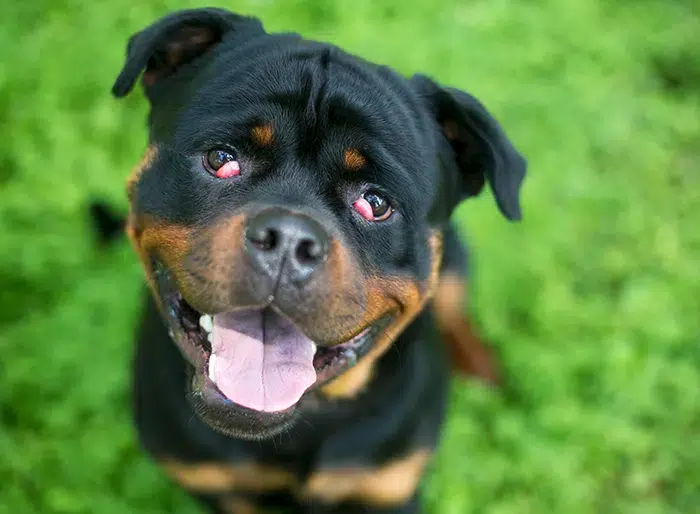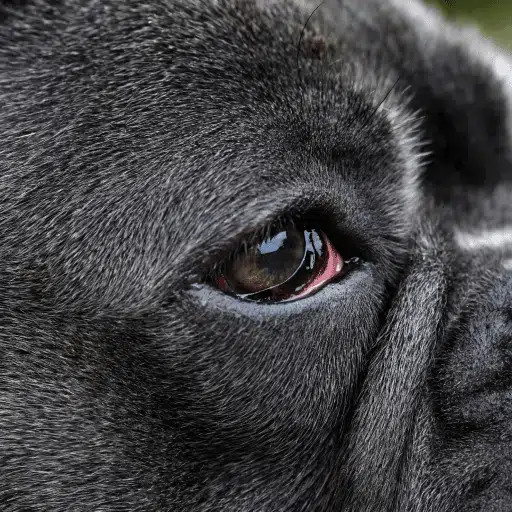What is Cherry eye in Dogs
The term "cherry eye in dogs" refers to the protrusion, or bursting out, of the third eyelid gland. A third eyelid, known as the nictitating membrane, is present in the lower eyelid of many mammals, including dogs. Particularly when hunting or engaging in combat, the third eyelid provides an extra degree of protection for the eye. Additionally, a unique gland found in the third eyelid generates a large amount of the tear film that shields the eye.
What are the clinical signs of cherry eye?
cherry eye in dogs involves a red, swelling mass on their lower eyelid that resembles a cherry near their nose or muzzle. In dogs, the cherry eye might be minor and only occurs occasionally, or it can be enormous and cover a major amount of the cornea. Any symptoms should be reported right away to your veterinarian.

What Causes Cherry Eye in Dogs?
Normally, a fibrous connection holds the gland responsible for the third eyelid to the lower inner rim of the eye. It is believed that in some dog breeds, this connection is weak, making the gland more prone to prolapse. The English Bulldog, French Bulldog, Cocker Spaniel, Beagle, Bloodhound, Lhasa Apso, Boston Terrier, Pug, Shih Tzu, and other brachycephalic (flat-faced) breeds are the most commonly afflicted by cherry eye in dogs.

Treatments of Cherry Eye in Dogs?
Cherry eye in dogs, the third eyelid gland must be surgically replaced. Treating the illness as soon as possible is crucial to preventing irreversible harm to the third eyelid gland or the eye. This is crucial since up to 50% of the tear film's watery component is produced by the gland located on the third eyelid. Your dog is far more prone to develop "dry eye," which can cause major vision impairment, if they do not produce enough tears.
It is not advised to remove the gland as a means of treatment. An artificial tears ointment can help keep the eye moist until surgery is possible. The ideal surgical method for your pet's condition will be discussed by your veterinarian.
There are a few methods for treating cherry eye in Dogs:
- Medication, To help the gland return to its natural position, the veterinarians may prescribe a mix of lubricants and anti-inflammatory drops.
- Using the surgical pocket procedure, the veterinarian would administer general anaesthesia to the animal and sew the gland back into its pocket. (This technique is not appropriate for young puppies because general anaesthesia is not advised unless it is absolutely required for very old or young Dogs.)
To see prices click here
Contact us about Cherry eye
Halesowen
Call us: 0121 296 7776 (24 hours)
Email us: info@localvets.co.uk
Pay us a visit:
Local Vets (Halesowen), Bromsgrove Road, Halesowen, West Midlands, B63 3JJ
Phone: 0121 296 7776
Monday: 9am – 6pm | Tuesday: 9am – 6pm | Wednesday: 9am – 6pm | Thursday: 9am – 6pm | Friday: 9am – 6pm | Saturday: 9am – 5pm
Oldbury
Call us: 0121 716 8000
Email us: info@localvets.co.uk
Pay us a visit:
LocalVets LTD (Oldbury) , Wolverhampton Road, Oldbury, West Midlands, B69 2BH
24 Hour Line: 0121 716 8000
Monday: 9am – 6.30pm | Tuesday: 9am – 6.30pm | Wednesday: 9am – 6.30pm | Thursday: 9am – 6.30pm | Friday: 9am – 6.30pm | Saturday: 9am – 5pm | Sunday: Emergencies Only

